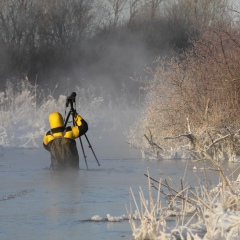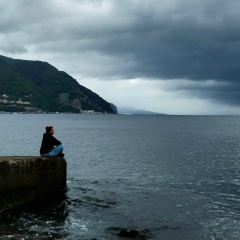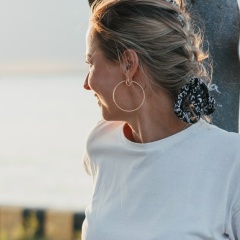Незаметно подкрался Новый Год, а в такое время обычно интересно провести анализ выполненных в ушедшем году проектов.
Конечно, более подробно можно будет послушать о них на моей лекции в понедельник 19 декабря в 19:00 в [club36964584|@anticafespb] по адресу 1-я линия В.О., д. 14, но и здесь я постараюсь окинуть ретроспективным взглядом свои проекты 2016 года.
Первое, что вспоминается – это зимородок. Потому что, как ни странно, с него начался для меня 2016 год. 4 января, в мороз -20 градусов, я встретил двух зимородков на притоке реки Оредеж. Вообще, на Оредеже устроен каскад плотин, в нижнем бьефе которых открытая вода держится круглый год. Более того, в этих же местах находится и оглушенная падением с высоты плотины рыба. Это дает основания зимородку проводить всю зиму в наших северных широтах, что я и наблюдаю уже более 15 лет.
Летом я занялся наблюдением за его привычками, чтобы как-то его локализовать и сделать приличный кадр. 600 мм объектива у меня нет, да и хорошего телеконвертера тоже, поэтому хороший кадр зимородка означает съемку с расстояния 3 – 4 метра. Под конец лета, ко времени выхода птенцов второго выводка мне удалось заметить продуктивную для себя закономерность в поведении родителей – прежде чем влететь в нору с кормом для птенцов, они каждый раз присаживались на корягу в 15 метрах от норы. С периодичностью около получаса. Дальше было дело техники – замаскироваться в плавучем скрадке и ждать. С первой засады удалось сделать кадр со щучкой в клюве, но метров с 6 – 8. Во вторую засаду я уже расположился поближе, зимородок несколько раз сел, но было еще слишком рано и темно для моей f4. С рассветом присаживания прекратились. Я огляделся и увидел, что птенец вышел из норы и сидит с обратной стороны моей плавучей засидки, на очень даже убойной дистанции не больше 5 метров. Затаив дыхание и представив себя невесомым перышком, я снял камеру со штатива, перевернулся на другую сторону засидки, просунул объектив через маскировочную сетку и сделал кадр. После того, как птенец слетел с присады, локализация семьи пропала – они стали летать и кормиться по всей реке и время ожидания у одной присады составило бы больше суток. Таким образом, сезон зимородка 2016 года был для меня завершен, однако полученный опыт представляется мне очень ценным и открывает определенные перспективы на сезон 2017 года.
Конечно, более подробно можно будет послушать о них на моей лекции в понедельник 19 декабря в 19:00 в [club36964584|@anticafespb] по адресу 1-я линия В.О., д. 14, но и здесь я постараюсь окинуть ретроспективным взглядом свои проекты 2016 года.
Первое, что вспоминается – это зимородок. Потому что, как ни странно, с него начался для меня 2016 год. 4 января, в мороз -20 градусов, я встретил двух зимородков на притоке реки Оредеж. Вообще, на Оредеже устроен каскад плотин, в нижнем бьефе которых открытая вода держится круглый год. Более того, в этих же местах находится и оглушенная падением с высоты плотины рыба. Это дает основания зимородку проводить всю зиму в наших северных широтах, что я и наблюдаю уже более 15 лет.
Летом я занялся наблюдением за его привычками, чтобы как-то его локализовать и сделать приличный кадр. 600 мм объектива у меня нет, да и хорошего телеконвертера тоже, поэтому хороший кадр зимородка означает съемку с расстояния 3 – 4 метра. Под конец лета, ко времени выхода птенцов второго выводка мне удалось заметить продуктивную для себя закономерность в поведении родителей – прежде чем влететь в нору с кормом для птенцов, они каждый раз присаживались на корягу в 15 метрах от норы. С периодичностью около получаса. Дальше было дело техники – замаскироваться в плавучем скрадке и ждать. С первой засады удалось сделать кадр со щучкой в клюве, но метров с 6 – 8. Во вторую засаду я уже расположился поближе, зимородок несколько раз сел, но было еще слишком рано и темно для моей f4. С рассветом присаживания прекратились. Я огляделся и увидел, что птенец вышел из норы и сидит с обратной стороны моей плавучей засидки, на очень даже убойной дистанции не больше 5 метров. Затаив дыхание и представив себя невесомым перышком, я снял камеру со штатива, перевернулся на другую сторону засидки, просунул объектив через маскировочную сетку и сделал кадр. После того, как птенец слетел с присады, локализация семьи пропала – они стали летать и кормиться по всей реке и время ожидания у одной присады составило бы больше суток. Таким образом, сезон зимородка 2016 года был для меня завершен, однако полученный опыт представляется мне очень ценным и открывает определенные перспективы на сезон 2017 года.
The New Year has crept quietly, and at such a time it is usually interesting to analyze the projects completed in the past year.
Of course, it will be possible to listen to them in more detail at my lecture on Monday, December 19, at 19:00 at [club36964584 | @anticafespb] at 14 VO 1st line, but here I will try to give a retrospective look their projects in 2016.
The first thing that comes to my mind is the kingfisher. Because, oddly enough, the year 2016 began for me with it. January 4, in a frost of -20 degrees, I met two kingfishers on a tributary of the Oredezh River. In general, a cascade of dams has been built on Oredezh, in the lower pool of which open water holds all year round. Moreover, in the same places there is a fish stunned by the fall from the height of the dam. This gives the kingfisher grounds to spend the whole winter in our northern latitudes, which I have been observing for more than 15 years.
In the summer, I began to observe his habits in order to somehow localize him and make a decent shot. I don’t have a 600 mm lens, and I don’t have a good tele-converter either, so a good kingfisher frame means shooting from a distance of 3-4 meters. At the end of summer, by the time the second brood chicks emerged, I managed to notice a pattern that was productive for myself in the behavior of my parents — before they flew into the hole with the chicks' food, they each time landed on a snag 15 meters from the hole. With a frequency of about half an hour. Next was a technical matter - to disguise ourselves in a floating skrad and wait. From the first ambush, I managed to take a shot with a little beak in my beak, but from 6-8 meters. In the second ambush I was already closer, the kingfisher sat several times, but it was still too early and dark for my f4. With the break of dawn, sitting down stopped. I looked around and saw that the chick came out of the hole and was sitting on the back of my floating hitch, at a very lethal distance of not more than 5 meters. Holding my breath and imagining myself as a weightless feather, I took the camera off the tripod, turned over to the other side of the ambush, stuck the lens through the camouflage net and shot. After the chick flew off the side of the attack, the localization of the family disappeared - they began to fly and feed across the river and the waiting time for one of the priests would have been more than a day. Thus, the kingfisher season of 2016 was completed for me, but the experience gained seems to me very valuable and opens up certain prospects for the 2017 season.
Of course, it will be possible to listen to them in more detail at my lecture on Monday, December 19, at 19:00 at [club36964584 | @anticafespb] at 14 VO 1st line, but here I will try to give a retrospective look their projects in 2016.
The first thing that comes to my mind is the kingfisher. Because, oddly enough, the year 2016 began for me with it. January 4, in a frost of -20 degrees, I met two kingfishers on a tributary of the Oredezh River. In general, a cascade of dams has been built on Oredezh, in the lower pool of which open water holds all year round. Moreover, in the same places there is a fish stunned by the fall from the height of the dam. This gives the kingfisher grounds to spend the whole winter in our northern latitudes, which I have been observing for more than 15 years.
In the summer, I began to observe his habits in order to somehow localize him and make a decent shot. I don’t have a 600 mm lens, and I don’t have a good tele-converter either, so a good kingfisher frame means shooting from a distance of 3-4 meters. At the end of summer, by the time the second brood chicks emerged, I managed to notice a pattern that was productive for myself in the behavior of my parents — before they flew into the hole with the chicks' food, they each time landed on a snag 15 meters from the hole. With a frequency of about half an hour. Next was a technical matter - to disguise ourselves in a floating skrad and wait. From the first ambush, I managed to take a shot with a little beak in my beak, but from 6-8 meters. In the second ambush I was already closer, the kingfisher sat several times, but it was still too early and dark for my f4. With the break of dawn, sitting down stopped. I looked around and saw that the chick came out of the hole and was sitting on the back of my floating hitch, at a very lethal distance of not more than 5 meters. Holding my breath and imagining myself as a weightless feather, I took the camera off the tripod, turned over to the other side of the ambush, stuck the lens through the camouflage net and shot. After the chick flew off the side of the attack, the localization of the family disappeared - they began to fly and feed across the river and the waiting time for one of the priests would have been more than a day. Thus, the kingfisher season of 2016 was completed for me, but the experience gained seems to me very valuable and opens up certain prospects for the 2017 season.



У записи 154 лайков,
7 репостов.
7 репостов.
Эту запись оставил(а) на своей стене Вадим Поляков





































































